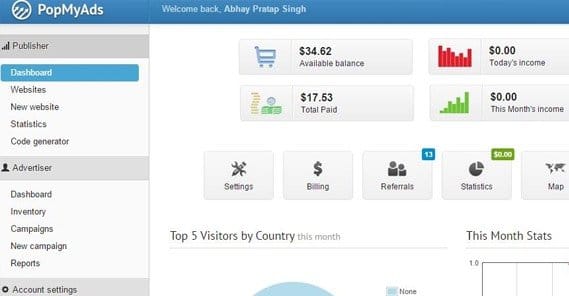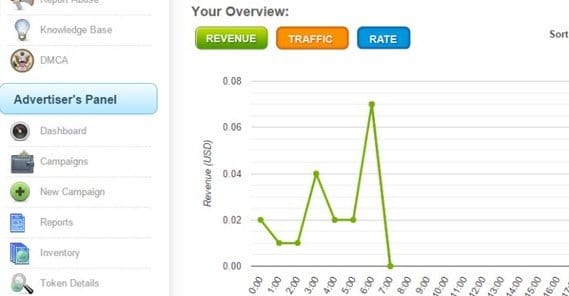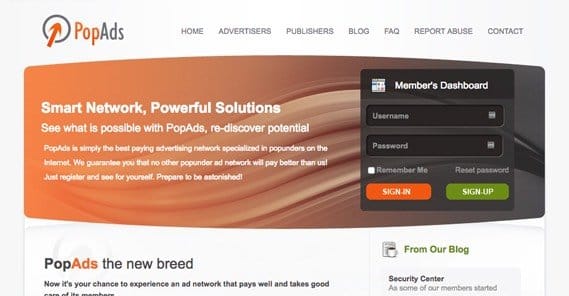Our Complete List of The Best Popunder Ad Networks

Popunder ads are an interesting old/new form of advertising. They’re not new, by a long shot; they have existed almost as long as their more irritating cousins, the pop-up ads. When you visit a site using a pop-under, the ad shows up in a new window, but that window doesn’t steal focus. It hides beneath the current browser window, waiting patiently for when you move, minimize, or close your browser. You then see the ad in all its glory, exposed to the world for the first time.
There are a lot of potential pros and cons with these sorts of advertisements, so let’s take a look at those before I give you the goods. Yes, I’ll get to the networks list, just bear with me first.
The Pros of Popunders
Popunders have a lot of benefits, though some of them are relatively minor. For example, popunder advertising tends to be very inexpensive. Some cheap PPM ads and low-level PPC can be cheaper, but popunders tend to be on the inexpensive side, even when you use parameters or advertise on sites that have higher costs elsewhere.
Popunders are also quite flexible. Since they’re loading essentially an entire landing page, you have a lot of potential options both for marketing directly, and for split-testing different variations on a theme. You can adjust them on the fly, and optimize your campaign based on a wealth of data you harvest from both the ad network analytics and your own.
Popunders are very discrete compared to pop-ups, lightboxes, and content-interrupting interstitials. A good metaphor might be the coupons handed to you with your receipt when you buy groceries. You probably don’t look at them or pay much attention to them when you check out, you simply toss them in a bag and move on. When you get home and unpack, you find them and give them another look. You’re immediately brought back to the events happening when you got them – the shopping trip – and they can remind you that you want X product. You can then save the coupon and use it in your next shopping trip.
Of course, this only works so long as the content of the popunder is unobtrusive. If your ad plays any kind of sound, chances are it’s going to be immediately hunted down and destroyed, while the user assigns a bad experience to your brand name in their memory. No one likes sound interrupting their browsing, and in particular people HATE sound they don’t know where it’s coming from. Not only is it disruptive, it’s also one of the signs of a virus, which is very much not an association you want to make.
Popunders also have the benefit of being the last thing a user sees in their browsing session, possibly to the level that they then immediately browse your site before finishing their session. There’s a bit of psychology there; they’ve mentally finished what they were doing, so they’re open and ready to receive your marketing without distractions. Well, presumably without distractions; if they’re ending their session due to the end of a work break or due to needing to go somewhere, you don’t get much time. It kind of balances out.
The Cons of Popunders
Popunder advertising is not a perfect form of marketing, and it should by no means be your only source of advertising. The drawbacks it has can be minor or major, and it largely depends on the sites using your ads and the users browsing those sites.
The first and most major con is the association with the pop-up. Pop-ups have a special place in the annals of advertising’s hall of shame. They were used and abused so much that web browsers started building in pop-up blockers by default. The user doesn’t even need an adblocker of their own, the browser does it for them.
Pop-up ads were, and still are, largely the domain of the shadier side of the internet. Online casinos, porn sites, and other such seedy sites use them, which means any business advertising using pop-ups tends to be associated with those sites, which isn’t great for many reputations. Popunders have a similar issue, in that those same sites have been quick to adopt them, so your site can still have those negative associations. Of course, it all depends on the network and who their publishers are.
Popunders have some level of security concern as well. They open a browser window without a user action attached to it, which can be a security concern. Ideally, they’re not being used maliciously, and indeed that hasn’t really been the case in recent years. However, it’s an area that has a lot of potential for abuse, and you can bet that the instant people do, popunders will be hit hard with all sorts of hammers.
Popunders have an additional effect of trying to stop people in their tracks when they’re down with a browsing session. Exit intent pops show up when a user is about to close a site, and get them to do one last thing. Popunders might spawn hours earlier, on an unrelated site, and can be pretty jarring to suddenly discover. The interest and the topic may be long past, and it’s possible that the user has no idea why your ad even appeared and will pay it no mind whatsoever.
There’s also the issue of adblockers. The mechanism that prevents pop-ups in modern browsers applies generally to all forms of window spawned without an explicit user command. Popunders are not generally user-created, so they can be caught by all of the same blocks.
The Network List
I’ve compiled a list of some of the best and most popular ad networks that do popunder advertising. You’ll probably recognize some of the names on this list from other lists, primarily because they handle more than just popunders, but several of them are specialists. I’ve tried to include some information for them as well, but nothing I say will be better than investigating the sites yourself. Read their terms, read their limitations, and decide for yourself if they’re right for you. Also, while a lot of the information below is geared towards publishers, I’ve tried to include the advertiser perspective as well.
PopAds – This is one of the top tier popunder ad networks, with a minimum payout of $5. They don’t have minimum requirements for traffic for a site in order to use them, they accept traffic from around the world, and their CPM rate is relatively high for US traffic. If you’re in an adult niche they will service you, but they also work with SFW sites.
ExoClick – Billing themselves as the fourth largest ad network in the world, this site has over 5 billion impressions globally per day. Their platform is entirely self-service with a lot of deep targeting options if you want to take advantage of them. They have pop-ups and popunders as well as other traditional ads. Their minimum payout is $20, though, and they seem to have a slightly lower CPM. As a bonus, they can pay via wire transfer in addition to the standard suite of e-payment options.
PopCash – This network is interesting in that it doesn’t seem to be blocked by common ad blockers. Their minimum payout is $10. They offer stats updated hourly, daily payments if you’re making enough, and a full dashboard to control your ad campaign. They approve sites quickly and are easy to integrate. Like PopAds, they accept both SFW and NSFW sites.
PopOnClick – This network allows you to choose geographically local targeting, and they claim that some publishers get as much as a $30 CPM. For advertisers, this can mean a pretty expensive set of ads, but it’s excellent for publishers. Their minimum payment level is $10, but they only seem to offer monthly payments.
RevenueHits – This is a well known network with a pretty good referral program (though my link is not a referral link, if you want to check) and a decent blog. They have high standards, however, and their minimum payout is $50, higher than the rest of this list thus far. In addition to popunders, they do display ads and text ads. Their popunders work on CPC, CPM, and CPA models depending on your needs.
Clicksor – One of the most reputable ad networks in the world, Clicksor has a long history and has quite a few high profile detractors who couldn’t cut it and take it out on those who can. They too have a $50 minimum payout, and have a variety of different ad styles, including text banners, in text ads, and interstitials.
Gunggo – Use this network with caution! They offer some shady types of ads, including video popunders, which can be pretty iffy for legit marketers. Word is they can be pretty lucrative, but there are some stories of unpaid balances that make me skeptical. They also seem to focus more heavily on adult sites, so if you’re not willing to run with that kind of crowd, you should steer clear.
PropellerAds – This is another one of the top-end, ultra-legit ad networks that has been in business for some time. They have global traffic but segment it for ideal targeting. Additionally, they get around adblockers by triggering their ads on clicks. The minimum payment is $100, or $500 if you’re using wire transfer, however. It’s a bit much if you’re operating at low volumes.
AdCash – This one is another of the boringly-named but effective ad networks. One gripe is that advertisers require a minimum buy-in of $1000, which can be a high hurdle if you’re looking for simple low-level testing. However, their geographic targeting is quite good, so you can do well with their traffic as an advertiser.
Ad Maven – This is one of the better but slightly lesser known networks around. They offer a wide range of advertising options, including banners, lightboxes, sliders, and popunders. Approval is near-immediate and it’s simple to get ads up and running in the span of minutes. Their minimum payout is $50 bi-weekly.
Bidvertiser – This ad network uses some pretty interesting methods for advertising. Their ads system is mixed with a bidding system that helps publishers in high demand niches earn more, while advertisers can optimize their budgets to appear at the best sites they can afford. They’re well worth checking out if you want to experiment.
JuicyAds – This network is interesting in that they bill themselves as “the sexy advertising network.” They have 81,000 clients through over 155,000 websites and have been in operation for a decade. However, as their branding implies, they work pretty much exclusively with adult sites. If you’re in the industry, it’s one of the best networks available. If not, it’s a no-go.
CPMoz – Not to be conflated with Moz.com, no relation. They’re consistent with their payments, they haven’t been known to scam people, and they have pretty high rates. They’re also the polar opposite of Juicy Ads in terms of content; they don’t accept adult content whatsoever. This means your sites will be in good company.
Adsterra – This is one of the top international ad networks with over ten billion views per month. They divide their traffic into 190 different geolocations, so you have pretty precise targeting. If you’re interested in that kind of thing, they also offer payments in Bitcoin.
Temporarily Offline / Dead Sites
These sites have been reported as offline, so whether its temporary or permanent, these networks still deserve an honorable mention:
AdOnly.com – This network is par for the course, a firm middle of the road choice. They have multiple ad formats in addition to popunders, they had a fill rate of 98% for publishers, and they have a high percentage revenue share. Nothing about them really stands out, though, either from a positive front or a negative one.
Final Thoughts and Comments
If you know of a network you can vouch for – that’s an important part, vouch for them as a user, not as an employee – mention it in the comments and I’ll check them out. I’m always open to adding new networks to the master list.
 ContentPowered.com
ContentPowered.com







Clicksor is shutdown – they’ve been gone for awhile now.
Thanks for letting us know!